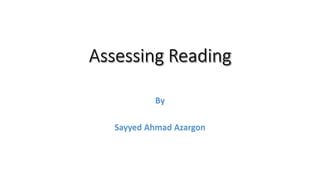
Assessing reading
- 2. • Defining reading .What did you do to understand the text? .So, what’s reading? .It is the ability to process a text through decoding, interpreting, and understanding it. (Brown, 2004) .It is a process of negotiating meaning. A dialogue between the reader and the writer. (Widdowson, 1984, 1990)
- 3. • Reading Importance In SLA reading is important because much info you need to know is communicated via written texts. We need reading to function in this modern society. It is a readily available exposure to the TL. It opens up worlds. It brings prior knowledge, cognitive development, and text processing. (Barnet, 1989) it is a social and cultural event involving written language. (Smith, 1984)
- 4. TYPES (GENRES) OF READING general interest articles (in magazines, newspapers, etc.) textbooks, theses essays, papers test directions editorials and opinion writing letters/emails reports (e.g., job evaluations, project reports) forms, applications, questionnaires financial documents (bills, invoices, etc.) letters, emails, greeting cards, invitations novels, short stories, jokes, drama, poetry financial documents (e.g., checks, tax forms, loan applications) forms, questionnaires, medical reports, immigration documents comic strips, cartoons
- 5. Genre of text • The genre of a text enables readers to apply certain schemata that will assist them in extracting appropriate meaning
- 6. Efficient readers 1.genre of text to apply certain schemata that will assist them in extracting appropriate meaning , 2.what their purpose is in reading a text , 3.the strategies for accomplishing that purpose, and 4.how to retain the information.
- 7. 1.Discriminate among the distinctive graphemes and orthographic patterns of English. 2.Retain chunks of language of different lengths in short-term memory. 3.Process writing at an efficient rate of speed to suit the purpose. 4.Recognize a core of words, and interpret word order patterns and their significance. 5.Recognize grammatical word classes (nouns, verbs, etc.), systems (e.g., tense, agreement, pluralization), patterns, rules, and elliptical forms. 6.Recognize that a particular meaning may be expressed in different grammatical forms. 7.Recognize cohesive devices in written discourse and their role in signaling the relationship between and among clauses.
- 8. 8.Recognize the rhetorical forms of written discourse and their significance for interpretation. 9.Recognize the communicative functions of written texts, according to form and purpose. 10.Infer context that is not explicit by using background knowledge 11.From described events, ideas, etc., infer links and connections between events, deduce causes and effects, and detect such relations as main idea, supporting idea, new information, given information, generalization, and exemplification. 12.Distinguish between literal and implied meanings. 13.Detect culturally specific references and interpret them in a context of the appropriate cultural schemata. 14.Develop and use a battery of reading strategies, such as scanning and skimming, detecting discourse markers, guessing the meaning of words from context, and activating schemata for the interpretation of texts.
- 9. 1.Identify your purpose in reading a text. 2.Apply spelling rules and conventions for bottom-up decoding. 3.Use lexical analysis (prefixes, roots, suffixes, etc.) to determine meaning. 4.Guess at meaning (of words, idioms, etc.) when you aren't certain 5.Skim the text for the gist and for main ideas. 6.Scan the text for specific information (names, dates, key words). 7.Use silent reading techniques for rapid processing. 8.Use marginal notes, outlines, charts, or semantic maps for understanding and retaining information. 9.Distinguish between literal and implied meanings. 10. Capitalize on discourse markers to process relationships.
- 10. .Concentrating on individual features .Focusing on individual words and phrases .Stringing details together to understand the whole .Looking down from above .Getting an overall picture .Having appropriate expectations (schemata)
- 12. •Perceptive reading tasks involve ending to the components of larger stretches of discourse: letters, words, punctuation, and other graphemic symbols. Bottom-up processing is implied.
- 13. • assessment involve: recognition of alphabetic symbols,capitalized and lowercase letters,punctuation,words,and grapheme-phoneme correspondences • Reading Aloud • written Response • Multiple-Choice • Picture-Cued Items
- 14. • To ascertain one’s reading recognition of lexical,grammatical,or discourse features of language within a very short stretch of language • A combination of bottom-up and top-down processing may be used.
- 15. Possible Assessment Tasks _Test designer focuses on formal aspects of language(lexical,grammatical,and a few discourse features) . Multiple-Choice vocabulary/ grammar tasks .matching tasks: .vocabulary matching task .selected response fill-in vocabulary task .editing tasks .picture-cued tasks .gap-filling tasks
- 16. • The aim of text is in a process of a psycholinguistic sense,interact with the reader,so reading is a process of negotiating meaning. • Typical genres of these reading are anecdotes,short narratives and description,questionnaires,memos,recipes. • Top-down processing is sometimes used for tasks although some instances of bottom-up performance may be necessary.
- 17. Possible Assessment Tasks • The focus of an interactive task is to identify relevant features (lexical,symbolic,grammatical, and discourse) within texts • Cloze tasks: .fixed-ratio deletion(every seventh word) .rational deletion(prepositions and conjunctions) .C-test procedure: the second half of every other word is omitted and test taker must restore each word .Cloze-elide procedure:insert words into a text that don’t belong and test taker must detect and correct that word • Impromptu Reading Plus Comprehension Questions: "Read a passage and answer some questions" technique • Short-answer tasks • Editing(longer texts) • Scanning • Ordering tasks
- 18. • It is text of more than a page and including professional articles,essays,technical reports,short stories, and books. • Using mostly top-down processing.with only occasional use of bottom-up strategy.
- 19. Possible Assessment Tasks • The aim of assessment is giving learner’s global understanding of a text and not to “zoom in” on small details. • Skimming Tasks • Summarizing and Responding • Note-taking and Outlining